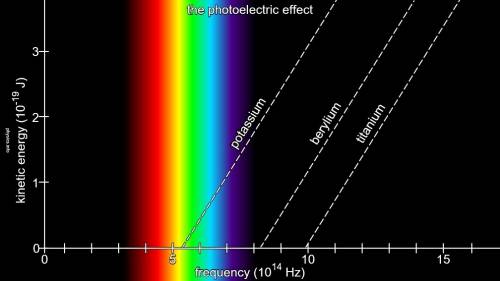
Physics, 19.07.2019 16:30 daniella1304
Use the following photoelectric graph to answer the following question: graph titled photoelectric effect for a photomissive metal is shown. the y axis is labeled kinetic energy and scales from negative 2 to positive 4 electron volts. the x axis is labeled frequency from 0 to 11 times 10 to the 14 hertz. a straight line connects the points 0, negative 1.2 and 5.5, 1 and 9, 2.5. if you use a different experimental photo-missive material, what would be the same on the graph? a the y-intercept b the intercept c the slope

Answers: 1
Another question on Physics

Physics, 21.06.2019 16:10
Avoltage source vs = 10 v is in series with a resistor of 10 kohm. if the source transformation theorem is applied, what will the value of the current source be in ma ?
Answers: 1

Physics, 21.06.2019 22:30
Follow these directions and answer the questions. 1. shine a pencil-thin beam of light on a mirror perpendicular to its surface. (if you don't have a laser light as suggested in the video, you can make a narrow beam from a flashlight by making a cone from black construction paper and taping it over the face of the flashlight.) how does the light reflect? how does the relationship of incident to reflected ray relate to the reflection of water waves moving perpendicular to a barrier? 2. shine a pencil-thin beam of light on a mirror standing on a sheet of paper on the table (or floor) so that you can mark the incident ray and reflected ray. (you can support the mirror from the back by taping it to a wooden block.) 3. mark a line on the paper representing the reflective surface. (the reflective surface of a mirror is usually the back edge.) 4. draw a dashed line perpendicular to the mirror surface at a point where the incident and reflected ray meet. this perpendicular is called a normal to the surface. 5. measure the angles between the rays and the normal. the angle of incidence is the angle formed by the incident ray and the normal to the surface. the angle formed by the reflected ray and normal is called the angle of reflection (r). what is the angle of incidence? what is the angle of reflection? 6. repeat for several different angles. (see report sheet for details.) what appears to be the relationship between the angle of incidence and angle of reflection? in science 1204, what was the relationship for these two angles made by the reflection of waves in a ripple tank? 7. roll a ball bearing so that it hits a fixed, hard surface (a metal plate) at several angles (including head-on). observe the way in which the ball bearing reflects. what generalization can you make about how a ball bearing reflects from a wall? have you proved that light can only behave like a wave?
Answers: 1

Physics, 22.06.2019 14:30
Alandscaper is shopping for landscaping materials. she wants to use materials through which water flows easily. which materials should she choose? check all that apply. clay gravel granite rocks with cracks loosely packed soil
Answers: 2

Physics, 22.06.2019 22:00
In the united states, tornadoes generally occur because of the freezing of ocean water underwater earthquakes meeting of cool and warm air masses shifting of warm and cool ocean currents
Answers: 2
You know the right answer?
Use the following photoelectric graph to answer the following question: graph titled photoelectric...
Questions

History, 07.07.2019 17:30


Mathematics, 07.07.2019 17:30





Biology, 07.07.2019 17:30

Mathematics, 07.07.2019 17:30

Mathematics, 07.07.2019 17:30


Biology, 07.07.2019 17:30




Mathematics, 07.07.2019 17:30

Social Studies, 07.07.2019 17:30






